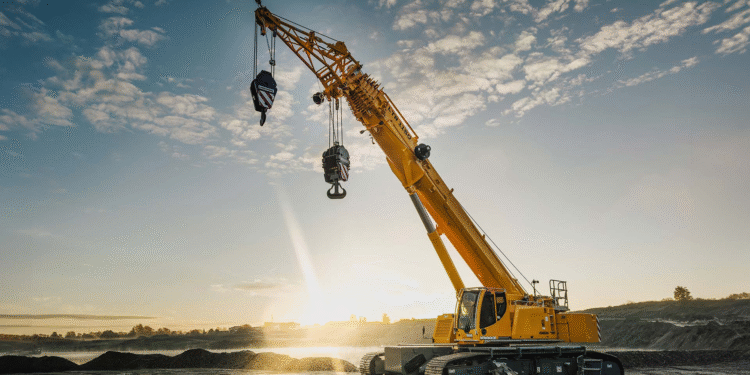Setting the right tone on any construction site begins with choosing the appropriate machinery. Efficiency is pivotal as it does not just add to the productivity but also ensures safety and punctuality in project completion. Among various equipment used on construction sites, the crawler crane has emerged as a fundamental piece of machinery designed to enhance efficacy and provide a solid foundation for high-capacity lifts.
The Strategic Advantage of Crawler Cranes
Crawler cranes distinguish themselves through their versatility and robustness. As they are mounted on an undercarriage with a set of tracks (or crawlers), they offer superior stability and can operate on a variety of terrains. This robustness allows for heavier lifting than many alternative cranes. Employing a crawler crane is therefore often a strategic decision, reflecting an understanding of the necessity for a reliable workhorse on the site.
Efficiency in construction is not merely about speed; it is about consistent, productive progress with minimal downtime. Crawler cranes contribute significantly to this aspect by enabling the transport of heavy materials across sites with fewer setups and without the need for constant repositioning. This reduces the time wasted on logistical considerations, directly enhancing on-site efficiency.
Enhanced Mobility and Stability
One of the key attributes influencing a construction project’s success is mobility. Crawler cranes offer an exceptional degree of mobility on site, especially on unprepared terrain. Their tracked system distributes the crane’s weight, enabling them to perform tasks in such environments without significant ground preparation. This is essential in maintaining timelines, as projects can run smoothly without waiting for ground conditions to be optimised.
Additionally, the inherent stability of crawler cranes allows for operations in a diverse range of weather conditions which is critical in project regions where weather can become an unforeseen obstacle. The ability to function reliably, regardless of external factors, is an invaluable feature that enhances on-site efficiency.
Crawler Cranes and Load Capacity
When it comes to heavy lifting, load capacity is a crucial determinant of efficiency. With their impressive lifting capacities, crawler cranes are instrumental in projects requiring the movement of substantial weights. This capability minimises the need for multiple machines and contributes to a more streamlined construction site, where a single crawler crane can perform the tasks of various machinery.
Furthermore, the effectiveness of a crawler crane in lifting and moving hefty objects reduces the risk of equipment failure and safety hazards. This assurance, coupled with high performance, ultimately drives operational efficiency.
Reducing Costs and Time
The economics of construction often revolves around the principles of cost and time. A crawler crane, with its substantial carrying capacities, reduces the number of lifts required and thus shortens the timeline for project completion. Fewer setups mean fewer man-hours, less wear and tear on equipment, and a reduced need for ancillary support equipment.
In essence, the crawler crane streamlines the construction process, which can result in significant savings. Fewer machines and quicker project completion times equate to lowered rental costs, reduced labour expenses, and minimised potential for overruns on budget or schedule.
Training and Expertise
As with any specialty equipment, operating a crawler crane requires a certain level of expertise. Effective training for operators is a critical factor in ensuring the crane’s productivity is maximised. Knowledgeable operators can make sound judgements on the siting of the crane, the most effective sequences of operation, and the management of risks, contributing significantly to on-site efficiency.
Moreover, skilled operators are also instrumental in ensuring the machine’s longevity by adhering to proper operating procedures. This not only mitigates the possibility of machine failure but also maintains consistent efficiency over a longer term.
Eco-Friendly and Future-Ready
Modern crawler cranes are increasingly designed with ecological considerations in mind. Their enhanced fuel efficiency not only saves costs but also reduces the environmental footprint of construction projects. Additionally, technological advancements continue to optimise crane operations, exemplified by innovative computer systems and telemetry that aid in precision and resource management, cementing the crawler crane’s position as a future-ready asset that is built for efficiency.
With technology continuing to evolve, the future of crawler cranes promises even greater potential to revolutionise efficiency on construction sites. Whether through improved control systems, the integration of artificial intelligence, or upgrades in materials and designs, crawler cranes are maintaining their trajectory of becoming increasingly integral to operational successes in the construction industry.
Conclusion
Efficiency on construction sites is a multifaceted challenge, requiring a blend of skilled labour, sound operational strategies, and reliable machinery. Amongst the equipment capable of transforming practices on-site, the crawler crane stands out. With its potent combination of mobility, stability, and lifting capacity, it represents a cornerstone of modern construction machinery.
Maximising efficiency using a crawler crane is not simply an effective strategy; it is an embodiment of taking the long view, investing in the provision of a safe, productive, and economic construction environment. For construction industries looking to push the envelope in on-site efficiency, the wise use of crawler cranes is not just beneficial—it is essential.
In a field where margins are often tight and schedules demanding, selecting the appropriate machinery is a critical decision. A crawler crane offers formidable benefits to those aiming for optimised operations, proving to be a pivotal tool at the forefront of industry best practices. On this solid foundation, efficiency in construction can not only be pursued but truly attained.













